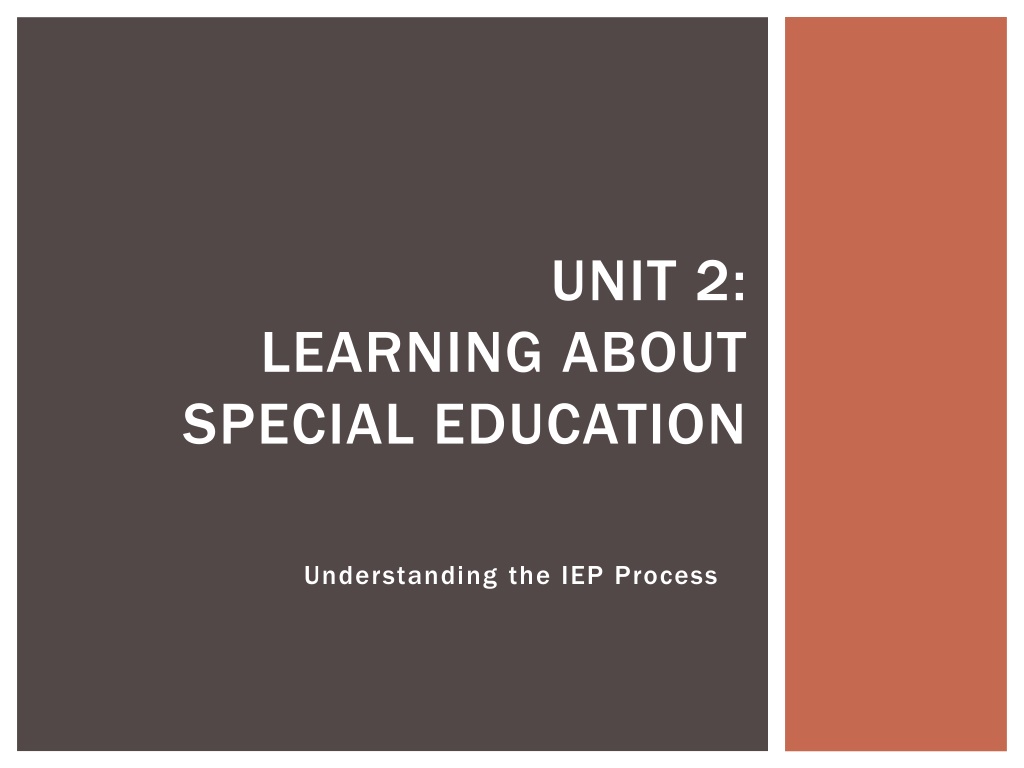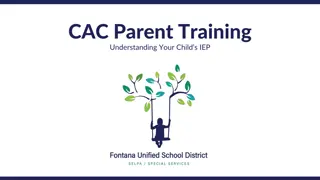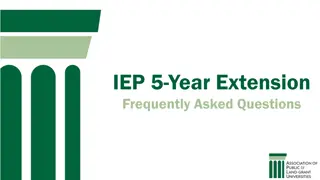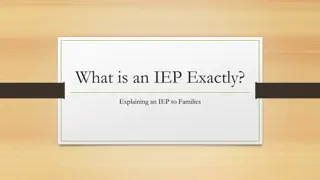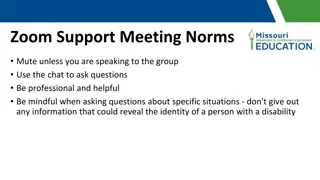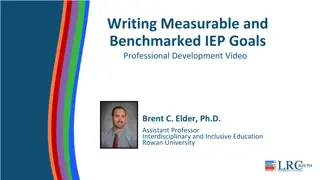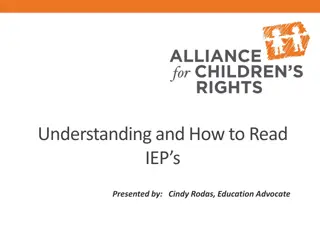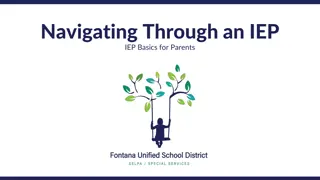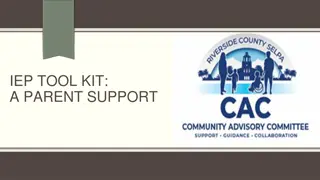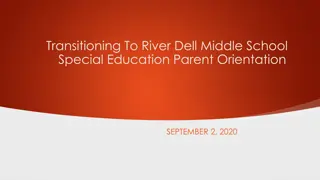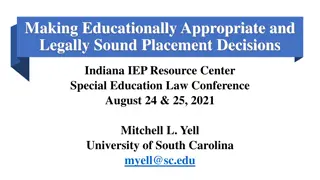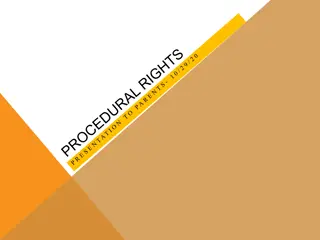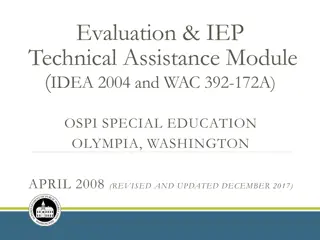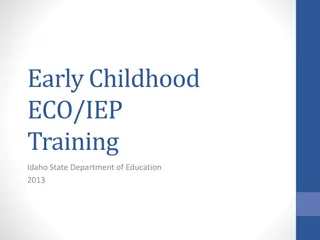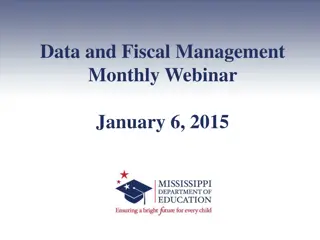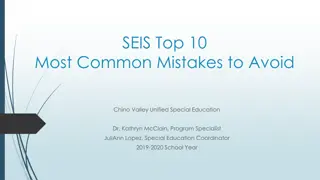Learning About Special Education: IEP Process
Discover the meaning of disability, societal treatment of individuals with disabilities, examples of barriers and low expectations, and explore historical perspectives. Engage in activities and reflect on personal experiences to gain insights into ableism, prejudices, and obstacles faced by people with disabilities. Dive into history with Victor's story and the origins of Individualized Education Plans (IEPs).
Download Presentation

Please find below an Image/Link to download the presentation.
The content on the website is provided AS IS for your information and personal use only. It may not be sold, licensed, or shared on other websites without obtaining consent from the author.If you encounter any issues during the download, it is possible that the publisher has removed the file from their server.
You are allowed to download the files provided on this website for personal or commercial use, subject to the condition that they are used lawfully. All files are the property of their respective owners.
The content on the website is provided AS IS for your information and personal use only. It may not be sold, licensed, or shared on other websites without obtaining consent from the author.
E N D
Presentation Transcript
UNIT 2: LEARNING ABOUT SPECIAL EDUCATION Understanding the IEP Process
BELL RINGER ACTIVITY 1 In your own words answer the following questions in 2 sentences: 1:What does the word DISABILITY DISABILITY mean? 2: How do you treat people with d disabilities? isabilities? 3. 3. How does society as a whole treat individuals with disabilities? 4. Do you think over the course of history people with disabilities have been treated better or worse?
BELL RINGER ACTIVITY 2 Write down the following words: barrier, prejudice, low expectations Write down your definitions of those words. *look them up if you re stuck* How do those words relate to people with disabilities?
BELL RINGER ACTIVITY 3 Find a partner Brainstorm on the following two questions. Be prepared to present your thoughts! What are some examples of low expectations towards individuals with disabilities? What are some examples of barriers? Did you know that 1 in 5 people in the world have some type of disability?
BELL RINGER ACTIVITY 4 Ableism Video Write down at least one thing that impacted you from the video.
BELL RINGER ACTIVITY 5 My Life Think about the barriers and prejudice people with disabilities have faced over the years. Have you experienced barriers and prejudice in your life? If so, describe at least one example of prejudice or a barrier you have experienced in your life. If not, explain why you think you have not experienced barriers or prejudice.
BELL RINGER ACTIVITY 6 In the late 1700 s, a boy named Victor was found wandering around in the woods in France. He was about 12 years old when he was found. It is believed that Victor had been alone in the woods for at least 7 years. A man named Itard took the boy home and taught him how to read, write and live around people. Some people say this was the first time in history that an IEP was used. Itard wrote out goals and objectives based on Victor s needs. Many people have studied the information Itard wrote about Victor and believe that if Victor were alive today he would be diagnosed with Autism. What is an IEP ?
BELL RINGER ACTIVITY 7 War has been a reoccurring event in history which has forced society to reevaluate how people view individuals with disabilities. The Vietnam War (1957-1975), The Gulf War (1990-1991), and the current wars in Iraq and Afghanistan-- one thing all of these wars have in common is that many veterans returned home with disabilities from their injuries. Many people began to change their attitude toward people with disabilities because they now had friends and/or family who returned home from war with a disability. Several examples of this include: The Revolutionary War (1775-1783), The Civil War (1861-1865), WW I (1914-1920), WWII (1939-1945), https://www.youtube.com/watch?v=OhKlZWLiPSk Do these men and women have disabilities?
BELL RINGER ACTIVITY 8 Civil Rights Movement The civil rights movement in the 1960 s also changed the way many people felt about people with disabilities. This was a time when minority groups, including Native Americans, Black Americans, and people with disabilities strongly advocated for equal rights. How do you think the Civil Rights movement impacts YOU?
BELL RINGER ACTIVITY 9 Since the 1970 s, other important legislation has been passed that has helped improve the lives of people with disabilities. Legislation that has impacted education includes: Individuals with Disabilities Education Act Americans with Disabilities Act Rehabilitation Act Section 504 Video Write down 6 facts or ideas from the video
BELL RINGER ACTIVITY 10 Video- What can you do? In 3 sentences, describe some things that YOU can do well. Write down the definitions of: Barrier Prejudice Low Expectation
BELL RINGER ACTIVITY 11 Define barrier, prejudice, and low expectation Now what is the definition of the following words *look them up if you need to*: Acronym- Accommodations- Modifications- Goals- Objectives-
BELL RINGER ACTIVITY 12 What do you think are the meanings of the following Acronyms 1. LOL 2. ROFL 3. SMH 4. IDEA 5. IEP 6. ITP 7. ADA
BELL RINGER ACTIVITY 13 Look at the following graph What are the following meetings *in your own words* 1. Eligibility Meeting 2. Annual Review 3. Triennial Meeting 4. Transition Meeting 5. Exit Meeting
BELL RINGER ACTIVITY 14 Why do you think you were considered ELIGIBLE (what does that mean?) to receive Specialized Education Services? How far back do you remember receiving help in school from Special Education? Do you even know what your IEP says? If not, why not?
BELL RINGER ACTIVITY 15 What is an IEP? Take a look at the following *Video*. List all of the things that you did not know about the IEP as presented in this video.
BELL RINGER ACTIVITY 16 What does it mean to have a disability? Are you alone? Does anybody become successful with a disability? Here s your answer
BELL RINGER ACTIVITY 17 Go back in your notebook and find the definitions of the following words and write them down. Self-Advocacy Self-Determination Self-Awareness Prejudices Barriers IEP IDEA Accommodations Modifications
BELL RINGER ACTIVITY 18 Creating My Story (2-3 sentences per question) Did you or your parents/guardians know you had a disability before you started school? How did they know? What grade were you in when you first realized that you had a difficult time with your schoolwork or being at school?
BELL RINGER ACTIVITY 19 Creating My Story (2-3 sentences per question) Who do you believe was the first person to notice you were having a difficult time in school? What do you think they saw that no one else saw? Can you remember some of the INTERVENTIONS that your teacher used with you before you were tested for Specialized Education? INTERVENTIONS *look it up*
BELL RINGER ACTIVITY 20 Creating My Story (2-3 sentences per question) What are some things you remember in elementary or middle school that could have been the result of being in special education. Did you go to a different classroom for part of the day? Did a different teacher come into your classroom to help you with work? Did you have a different reading or math book than the other students? What is the first thing you can remember about being in special education? How did it make you feel?
BELL RINGER ACTIVITY 21 Creating My Story (2-3 sentences per question) Do you remember anyone telling you what type of disability you have? Who told you? How did this make you feel? Do the people in your family talk about your disability or Special Education? How does it make you feel? Do your friends know you are in Special Education? Do they say anything about it? How does that make you feel?
BELL RINGER ACTIVITY 22 Creating My Story (2-3 sentences per question) How does being in Special Education make your school day different from other students who are not in Special Education?
BELL RINGER ACTIVITY 23 Creating My Story (2-3 sentences per question) What are your education (college, tech center, military, etc.) plans for after high school graduation? Where do you want to be living one year after graduation? What kind of job do you want to have during your education time period? What is the dream job for the rest of your life? Poster Activity (One class period for projects)
POSTER PROJECT! For the bell work the last few days you have been compiling information about your history. You are now going to create a poster that shows three primary areas. 1.) Where you came from (History) 2.) Where you are now (Who are you currently) and 3.) Where are you going to be in the future (Think: Graduation, one year after, and finally The rest of your life ) You may draw, create a chart, a timeline, a comic strip, whatever you want. But make something that you would be proud to display.
